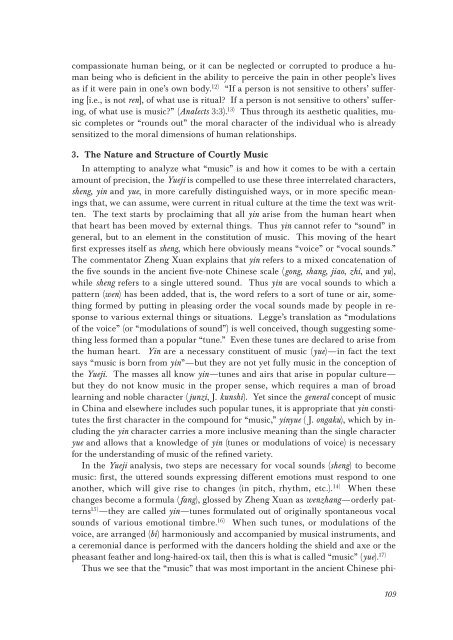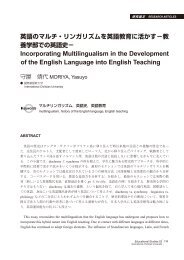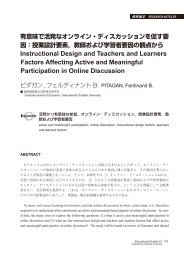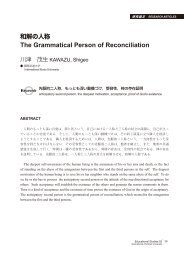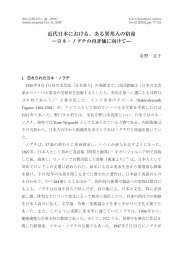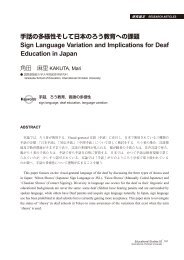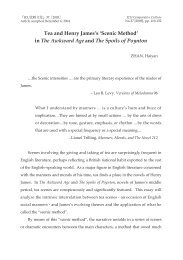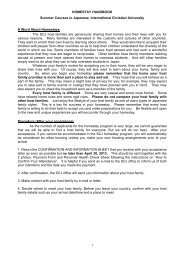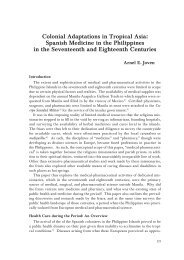The Culture of Music and Ritual in Pre-Han Confucian - subsite
The Culture of Music and Ritual in Pre-Han Confucian - subsite
The Culture of Music and Ritual in Pre-Han Confucian - subsite
Create successful ePaper yourself
Turn your PDF publications into a flip-book with our unique Google optimized e-Paper software.
compassionate human be<strong>in</strong>g, or it can be neglected or corrupted to produce a human<br />
be<strong>in</strong>g who is deficient <strong>in</strong> the ability to perceive the pa<strong>in</strong> <strong>in</strong> other people’s lives<br />
as if it were pa<strong>in</strong> <strong>in</strong> one’s own body. 12) “If a person is not sensitive to others’ suffer<strong>in</strong>g<br />
[i.e., is not ren], <strong>of</strong> what use is ritual? If a person is not sensitive to others’ suffer<strong>in</strong>g,<br />
<strong>of</strong> what use is music?” (Analects 3:3). 13) Thus through its aesthetic qualities, music<br />
completes or “rounds out” the moral character <strong>of</strong> the <strong>in</strong>dividual who is already<br />
sensitized to the moral dimensions <strong>of</strong> human relationships.<br />
3. <strong>The</strong> Nature <strong>and</strong> Structure <strong>of</strong> Courtly <strong>Music</strong><br />
In attempt<strong>in</strong>g to analyze what “music” is <strong>and</strong> how it comes to be with a certa<strong>in</strong><br />
amount <strong>of</strong> precision, the Yueji is compelled to use these three <strong>in</strong>terrelated characters,<br />
sheng, y<strong>in</strong> <strong>and</strong> yue, <strong>in</strong> more carefully dist<strong>in</strong>guished ways, or <strong>in</strong> more specific mean<strong>in</strong>gs<br />
that, we can assume, were current <strong>in</strong> ritual culture at the time the text was written.<br />
<strong>The</strong> text starts by proclaim<strong>in</strong>g that all y<strong>in</strong> arise from the human heart when<br />
that heart has been moved by external th<strong>in</strong>gs. Thus y<strong>in</strong> cannot refer to “sound” <strong>in</strong><br />
general, but to an element <strong>in</strong> the constitution <strong>of</strong> music. This mov<strong>in</strong>g <strong>of</strong> the heart<br />
first expresses itself as sheng, which here obviously means “voice” or “vocal sounds.”<br />
<strong>The</strong> commentator Zheng Xuan expla<strong>in</strong>s that y<strong>in</strong> refers to a mixed concatenation <strong>of</strong><br />
the five sounds <strong>in</strong> the ancient five-note Ch<strong>in</strong>ese scale (gong, shang, jiao, zhi, <strong>and</strong> yu),<br />
while sheng refers to a s<strong>in</strong>gle uttered sound. Thus y<strong>in</strong> are vocal sounds to which a<br />
pattern (wen) has been added, that is, the word refers to a sort <strong>of</strong> tune or air, someth<strong>in</strong>g<br />
formed by putt<strong>in</strong>g <strong>in</strong> pleas<strong>in</strong>g order the vocal sounds made by people <strong>in</strong> response<br />
to various external th<strong>in</strong>gs or situations. Legge’s translation as “modulations<br />
<strong>of</strong> the voice” (or “modulations <strong>of</strong> sound”) is well conceived, though suggest<strong>in</strong>g someth<strong>in</strong>g<br />
less formed than a popular “tune.” Even these tunes are declared to arise from<br />
the human heart. Y<strong>in</strong> are a necessary constituent <strong>of</strong> music (yue)–<strong>in</strong> fact the text<br />
says “music is born from y<strong>in</strong>”–but they are not yet fully music <strong>in</strong> the conception <strong>of</strong><br />
the Yueji. <strong>The</strong> masses all know y<strong>in</strong>–tunes <strong>and</strong> airs that arise <strong>in</strong> popular culture–<br />
but they do not know music <strong>in</strong> the proper sense, which requires a man <strong>of</strong> broad<br />
learn<strong>in</strong>g <strong>and</strong> noble character (junzi, J. kunshi). Yet s<strong>in</strong>ce the general concept <strong>of</strong> music<br />
<strong>in</strong> Ch<strong>in</strong>a <strong>and</strong> elsewhere <strong>in</strong>cludes such popular tunes, it is appropriate that y<strong>in</strong> constitutes<br />
the first character <strong>in</strong> the compound for “music,” y<strong>in</strong>yue ( J. ongaku), which by <strong>in</strong>clud<strong>in</strong>g<br />
the y<strong>in</strong> character carries a more <strong>in</strong>clusive mean<strong>in</strong>g than the s<strong>in</strong>gle character<br />
yue <strong>and</strong> allows that a knowledge <strong>of</strong> y<strong>in</strong> (tunes or modulations <strong>of</strong> voice) is necessary<br />
for the underst<strong>and</strong><strong>in</strong>g <strong>of</strong> music <strong>of</strong> the ref<strong>in</strong>ed variety.<br />
In the Yueji analysis, two steps are necessary for vocal sounds (sheng) to become<br />
music: first, the uttered sounds express<strong>in</strong>g different emotions must respond to one<br />
another, which will give rise to changes (<strong>in</strong> pitch, rhythm, etc.). 14) When these<br />
changes become a formula (fang), glossed by Zheng Xuan as wenzhang–orderly patterns<br />
15) –they are called y<strong>in</strong>–tunes formulated out <strong>of</strong> orig<strong>in</strong>ally spontaneous vocal<br />
sounds <strong>of</strong> various emotional timbre. 16) When such tunes, or modulations <strong>of</strong> the<br />
voice, are arranged (bi) harmoniously <strong>and</strong> accompanied by musical <strong>in</strong>struments, <strong>and</strong><br />
a ceremonial dance is performed with the dancers hold<strong>in</strong>g the shield <strong>and</strong> axe or the<br />
pheasant feather <strong>and</strong> long-haired-ox tail, then this is what is called “music” (yue). 17)<br />
Thus we see that the “music” that was most important <strong>in</strong> the ancient Ch<strong>in</strong>ese phi-<br />
109


